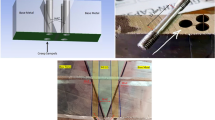Abstract
The effect of oxygen content on the susceptibility of high-strength weld metal to hydrogen cracking is examined. Increasing oxygen content had a detrimental effect on the cracking susceptibility of weld metal containing a dψusible hydrogen content of 4.7 ppm. In weld metal containing a much lower dψusible hydrogen content (0.87 ppm), increasing weld metal oxygen content had no detrimental effect on hydrogen cracking susceptibility. These results are explained by a model which proposes that hydrogen cracking occurs when a critical oxide inclusion density promotes intergranular fracture at prior austenite grain boundaries and when a critical level of hydrogen is present in the weld metal. For the same level of hydrogen (moisture) contamination, high-strength weld metals containing oxygen contents greater than 200 ppm will be much more susceptible to hydrogen cracking than deposits made using inert gas-shielded or vacuum-operated welding processes.
Similar content being viewed by others
Abbreviations
- α 1 :
-
coefficient of thermal expansion of the inclusion
- α 2 :
-
coefficient of thermal expansion of the matrix
- τ :
-
temperature change involved
- Ó c :
-
circumferential stress
- Ó r :
-
radial stress
- d :
-
ratio ofR 1 toR 2
- R 1 :
-
radius of the inclusion
- R 2 :
-
outer radius of the matrix shell associated with the inclusion
- ν 1 :
-
Poisson’s ratio of the inclusion
- ν 2 :
-
Poisson’s ratio of the matrix
- E 1 :
-
Young’s modulus of the inclusion
- E 2 :
-
Young’s modulus of the matrix
- d 1 :
-
volume fraction of inclusions
References
F. Matsuda, H. Nakagawa, and K. Shinozaki:Trans. Jpn. Weld. Res. Inst., 1979, vol. 8, p. 113.
F. Matsuda, H. Nakagawa, and K. Shinozaki: Int. Inst. Weld. Doc, 1X-1403-86, 1986.
P. Holsberg:Proc. World Materials Conf. Marine Military and Pressure Vessels, Chicago, IL, Sept. 1988.
T.W. Montemarano, B.P. Sack, J.P. Gudas, M.G. Vassilaros, and H.H. Vanderveldt:J. Ship Prod., 1986, vol. 2, p. 145.
G.M. Pressouyre and I.M. Bernstein:Metall. Trans. A, 1981, vol. 12A, pp. 835–44.
G.M. Pressouyre:Acta Metall., 1980, vol. 20, p. 895.
H. Hargi, Y. Hayashi, and N. Ohtani:Trans. Jpn. Inst. Met., 1979, vol. 20, p. 349.
J.-L. Lee and J.-Y. Lee:Metall. Sci., 1983, vol. 17, p. 426.
G.M. Pressouyre and C. Zmudminski:Proc. Conf. on Mechanical Working and Steel Processing XVIII, AIME, New York, NY, 1981.
J.-L. Lee and J.-Y. Lee:Metall. Trans. A, 1986, vol. 17A, pp. 2183–86.
K.Y. Lee and J.-Y. Lee:Mater. Sci. Eng., 1984, vol. 6, p. 213.
A.A.B. Sugden and H.K.D.H. Bhadeshia:Metall. Trans. A, 1988, vol. 19A, pp. 669–74.
O. Grong, T.A. Siewert, G.P. Martins, and D.L. Olson:Metall. Trans. A, 1986, vol. 17A, pp. 1797–1807.
J. Burkhardt, T. Lau, T.H. North, and G.L. L’Esperance:Weld. J., 1988, vol. 66, p. 87.
R.B. Cochrane, J.L. Ward, and B.R. Keville:Proc. Conf. Effect of Residual and Microalloying Elements on Weldability and Weld Properties,The Welding Institute, London, Nov., 1983.
D. Abson and R.E. Dolby:Weld. Res. Bull., 1978, vol. 19, p. 202.
F. Matsuda, H. Nakagawa, and K. Shinozaki:Trans. Jpn. Weld. Res. Inst., 1978, vol. 7, p. 135.
F. Kurozawa, I. Taguchi, and R. Masumoto:J. Jpn. Inst. Met., 1979, vol. 43, p. 1068.
C.D. Beachem:Metall. Trans., 1972, vol. 3, p. 437.
D. Brooksbank and K.W. Andrews:J. Iron Steel Inst., 1972, vol. 210, p. 246.
D. Brooksbank and K.W. Andrews:J. Iron Steel Inst., 1970, vol. 208, p. 582.
A.R. Troiano:Trans. ASM, 1960, vol. 52, p. 54.
W. Beck, J.M. O’Brien, and L. Nanis:Proc. R. Soc., 1966, vol. A290, p. 220.
T. Tabata and H.K. Birnbaum:Scripta Metall., 1984, vol. 18, p. 231.
T.P. Pemg and C.J. Altstetter:Metall. Trans. A, 1987, vol. 18A, p. 123.
F. Matsuda, K. Nakagawa, and Y. Morimoto:Trans. Jpn. Weld. Res. Inst., 1986, vol. 7, p. 87.
J.M. Dowling, J.M. Corbett, and H.W. Kerr:Metall. Trans. A, 1986, vol. 17A, pp. 1611–23.
L. Devillers, D. Kaplan, A. Ribes, and P.V. Riboud: IRSID Report 81.S.0660, Oct. 1981.
S.G. Court and G. Pollard:J. Mater. Sci. Lett., 1985, vol. 4, p. 427.
G.M. Evans:Metall. Constr., 1986, vol. 18, p. 631R.
X. Mao, H. Nakagawa, and T.H. North: University of Toronto, Toronto, ON, Canada, unpublished research, 1989.
P.H.M. Hart:Trends in Steels and Consumables for Welding, Proc. Conf., The Welding Institute, London, Nov. 1984.
N. Yurioka, M. Koike, N. Mori, and K. Nagano: Int. Inst. Weld. Doc. 1X-1313-84, 1984, p. 11.
Z. Wenyue, Q. Boxiong, C. Banguu, and D. Zevu:Weld. Res. Rev., Tianjin University, Tianjin, China, 1987.
F. Nakasato and F. Terasaki:J. Jpn. Met., 1975, vol. 38, p. 667.
Author information
Authors and Affiliations
Additional information
Formerly Visiting Scientist, Department of Metallurgy and Materials Science, University of Toronto
Rights and permissions
About this article
Cite this article
Shinozaki, K., Wang, X. & North, T.H. Effect of oxygen on hydrogen cracking in high-strength weld metal. Metall Trans A 21, 1287–1298 (1990). https://doi.org/10.1007/BF02656545
Received:
Issue Date:
DOI: https://doi.org/10.1007/BF02656545




